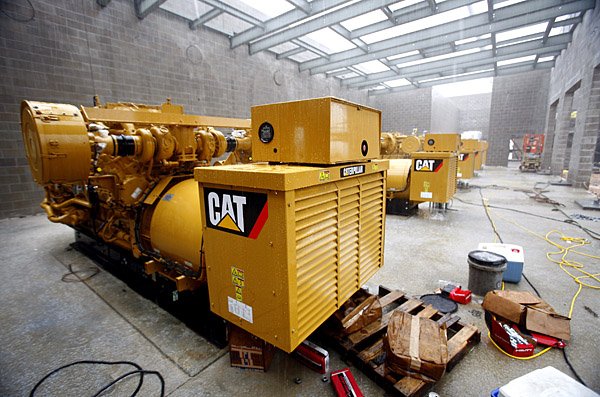TONTITOWN — The power plant being built at Waste Management’s Eco-Vista landfill is nearing the halfway point in construction and is expected to start turning methane into electricity by early October.
The four-megawatt plant, powered by five 16-cylinder engines, will be fueled by methane piped in from the old landfill and eventually from the new landfill when it has enough decaying material, Waste Management officials said.
The plant will generate enough energy to power 4,000 homes a year. The electricity will be sold to Ozarks Electric Cooperative, which serves 66,000 customers in the region.
“It’s just a smidgen oftheir needs, but every little bit helps,” Waste Management spokesman George Wheatley said.
Wa s t e Management, which operates four landfills in Arkansas and hundreds across the country, operates 60 methane plantsand is building dozens more, Wheatley said. The Two Pine landfill in Jacksonville already has a methane plant. A third such plant is proposed for Fort Smith, but has yet to permitted.
Methane plants are more environmentally friendly because they offset the need for nonrenewable resources such as coal and oil, said Wheatley.
Methane is produced as organic material as the landfill decomposes. The current system to burn off the growing amount of methane in the dump uses a flare to burn off the gas and convert it into carbon dioxide, Wheatley said.
Waste Management’s renewable resources division has developed plants that convert methane into boiler fuel, or fuel for automotive fleets. Some plants clean and condense the gas so it can be sold.
The benefit for Ozarks Electric is that the extra electricity means the company can reduce “line loss,” the amount of power needed to push electricity across the system, said Troy Scarbrough, vice president of engineering and operations for Ozarks Electric. The Ozarks system loses about 5 percent of its electricity during thetransmission, which Scarbrough said is an acceptable amount.
The new power source also will allow the cooperative to defer upgrades to its transmission system, Scarbrough said.
Construction of the $8 million facility is being managed by Wisconsin-based T.V. John and Son. The company has served as Waste Management’s plant construction arm for the last six years. The company qualifies the bids and hires the subcontractors. T.V. John has built facilities across the country and in Canada.
Site superintendent Steve Cochrane with T.V. John said the plant is being built so that it can be upgraded with another engine room or larger engines. A plant takessix months to build and one month to “shake out,” said Cochrane, referring to the process of testing the plant’s operating system. Minor electrical glitches are common.
“The hardest part is to get [environmental] permits on the front end,” he said.
The plant was permitted by the Arkansas Department of Environmental Quality.
Mike Bates, ADEQ’s chief of the Air Division, described the Eco-Vista permit as “major,” and said an exhaustive set of federal guidelines had to be met before the permit was issued.
It took Waste Management about 10 months to get the permit. Bates said the company’s consulting engineers and ADEQ’s engineers wentback and forth before all the issues regarding equipment, emissions and testing were settled.
“It’s hard to get through the federal regulations to where it makes sense on the ground,” Bates said. “There has to be a way of verifying that what’s in the permit is actually taking place in the field.”
Northwest Arkansas, Pages 7 on 07/12/2010

